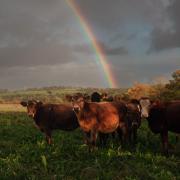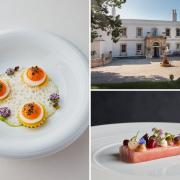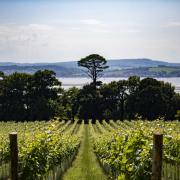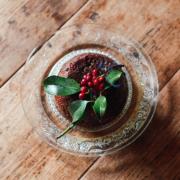Slice of profits from new spirit will go to protect rediscovered Dartmoor creature

Moretonhampstead, the busy working town within the National Park, is home to Papillon Dartmoor Distillery. Owners, Claire and Adam Hyne, wanted to run a business in their home town which reflected the unique landscapes and flavours of the moor.
Having been a master thatcher for 30 years, Adam is keen to grow the business so he no longer has to be on a roof in the rain, wind and snow! Through her previous role at the National Lottery Heritage Fund, Claire came into contact with many interesting natural heritage projects on Dartmoor and chose a local butterfly conservation one to focus the business on.
Named Papillon for the Pearl Bordered Fritillary, an endangered butterfly resident on Dartmoor, 1% from all bottle sales are donated to the project to help protect these important butterflies. These Fritillaries feed on wild violets and one of the botanicals in Papillon Gin is locally grown Devon violets. As well as donating to the project, Claire volunteers and is often seen out surveying in the summer months.

READ MORE: How to attract green woodpeckers into your garden
Conservation is at the heart of this Dartmoor business so it is no surprise they have teamed up with Dartmoor naturalist Nick Baker to create a new gin. When asked to pick a significant Dartmoor species to focus the new gin on, Nick chose the Blue Ground Beetle (Carabus Intricatus). Thought to be extinct, this rare beetle was rediscovered on Dartmoor in 1985. It seems to be confined to a few ancient woodlands where it nestles in the damp moss during the day and comes out at night to prey upon unsuspecting slugs.
Not content with just reading about the beetle, Claire and Adam joined Nick one night to explore a local woodland with John Walters, the Blue Ground Beetle expert, to seek out this elusive bug. They were lucky enough to spot a few.

Woodland flavours feature in this new gin, named Carabus in honour of this special beetle. Alongside the usual gin botanicals it is distilled with rowan and hawthorn berries, nettles, wood sorrel and hazelnuts.
Papillon Dartmoor Distillery has now teamed up with Buglife, the charity that supports invertebrates, and £2 from every bottle of Carabus sold will be donated towards a project helping the Blue Ground Beetle.
BLUE GROUND BEETLE FACTS
Adult beetles can be 3cm long.
It has large protruding jaws so it can capture slugs and suck out their insides!
Long wiry limbs help it climb up trees to find its prey.
It is estimated that Dartmoor represents over 80% of the Blue Ground Beetle population in the UK.
First discovered in 1811, it was soon presumed extinct. Rewards were offered by collectors for a specimen. One disappointed bounty hunter was only offered a fraction of the reward in 1856, due to missing legs on the beetle. The species then disappeared until rediscovered on Dartmoor in 1985.
Join our Facebook group to keep up to date with the latest news, events and people in Devon




























